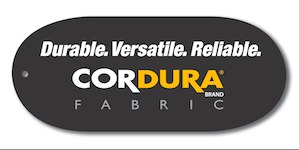Cordura
This article has multiple issues.Please helpimprove itor discuss these issues on thetalk page.(Learn how and when to remove these template messages)
|


Cordurais a collection ofsynthetic fiber-basedfabricsused in products includingluggage,backpacks,trousers,militarywear, and performanceapparel.[1]
It was developed and trademarked byE.I. du Pont de Nemours and Company(DuPont) in 1929. Cordura is currently owned byInvista,a subsidiary ofKoch Industries.[2]
Overview[edit]
DuPont initially introduced the fabric as a type ofrayon.[3][4]In a 1948 advertisement,DuPontdescribed the research that led to its creation: “DuPont scientists were working to improve on the properties of rayon… Out of the cooperation among scientists—ranging from studies of cellulose as a high polymer to design of enormous plants—came a new product, 'Cordura' high-tenacity rayon, as strong as mild steel yet able to stand up under repeated flexing.”[5]
Cordura was further developed duringWorld War IIand used in tires for military vehicles. By 1966, with the arrival of superiornylonformulations, the Cordura brand name was transferred to nylon products. In 1977, a process for dyeing Cordura was discovered, leading to a broader range of commercial applications.Eastpakwas the first brand to use Cordura fabric in their luggage.[6]By 1979, soft-sided Cordura luggage made up about 40 percent of the luggage market.JanSportused the canvas-like nylon in their original daypacks in the 1970s, and now exclusively usespolyesterCordura.[7]In the 1980s, Manhattan Portage began using 1000denier(D) Cordura nylon in their bags.[8]During the 1990s, European workwear clothing brands adopted the 1000D and 500D fabric for reinforcements. Brands like F. Engel, Fristads Kansas, Snickers and Scruffs use Cordura in their clothing. Today, Cordura is used in textile motorcycle jackets and pants for abrasion resistance, with companies such asKlim,Rukka,MotoPort,Rev'It!,Olympia,Aerostich,and Dainese incorporating it into their gear.[9]
Variants of Cordura fabrics vary in weight, appearance, tear resistance, and color retention. There are alsobase layer,denim,and canvas fabrics that blends Invista 420 D nylon 6, 6 fiber, and cotton, known as "Cordura Baselayer," "Cordura Denim," and "Cordura Duck," respectively.[10]
Some Cordura fabrics have been specifically designed for military applications and extended outdoor use.[11][12]
References[edit]
- ^"CORDURA® Brand - Home".www.cordura.com.
- ^"Koch Subsidiaries Buy Fibers Unit from DuPont".Invista.com. 2004-04-30. Archived fromthe originalon 2011-05-24.Retrieved2011-10-18.
- ^"Cordura".dupont.com. 2009-02-02. Archived fromthe originalon 2011-07-31.Retrieved2011-10-18.
- ^"A Short History of Manufactured Fibers".Fibersource.com. 1969-07-20. Archived fromthe originalon 2008-05-11.Retrieved2011-10-18.
- ^”Du Pont Digest” (advertisement), Notre Dame Scholastic, Vol 89 No. 21, 9 April 1948, 7.
- ^RETROFUZZ."Collection 2011 | Quinze & Milan x Eastpak | Built to Resi(s)t".Eastpak.com. Archived fromthe originalon 2011-09-29.Retrieved2011-10-18.
- ^"EcoTextiles Just Got Tougher: Cordura EcoMade".TreeHugger. Archived fromthe originalon 2010-03-28.Retrieved2011-10-18.
- ^"Manhattan Portage Bags - Company Information".Manhattanportage.com. 2011-08-17. Archived fromthe originalon 2017-06-09.Retrieved2011-10-18.
- ^"Save Your Hide Article".Motoport.com. Archived fromthe originalon 2009-02-21.Retrieved2011-10-18.
- ^"Invista Unveils Cordura Denim Fabric".Textile World.Retrieved2011-10-18.
- ^Rayfield, Susannah."The First Line of Defence: The Infantry Soldier"(PDF).Cordura Fabric.Sovereign Publications. Archived fromthe original(PDF)on 2017-07-03.Retrieved2019-02-06.
- ^"Outdoor Research Ferrosi Hoody".Outdoorinformer.com. Archived fromthe originalon 2010-06-27.Retrieved2011-10-18.
